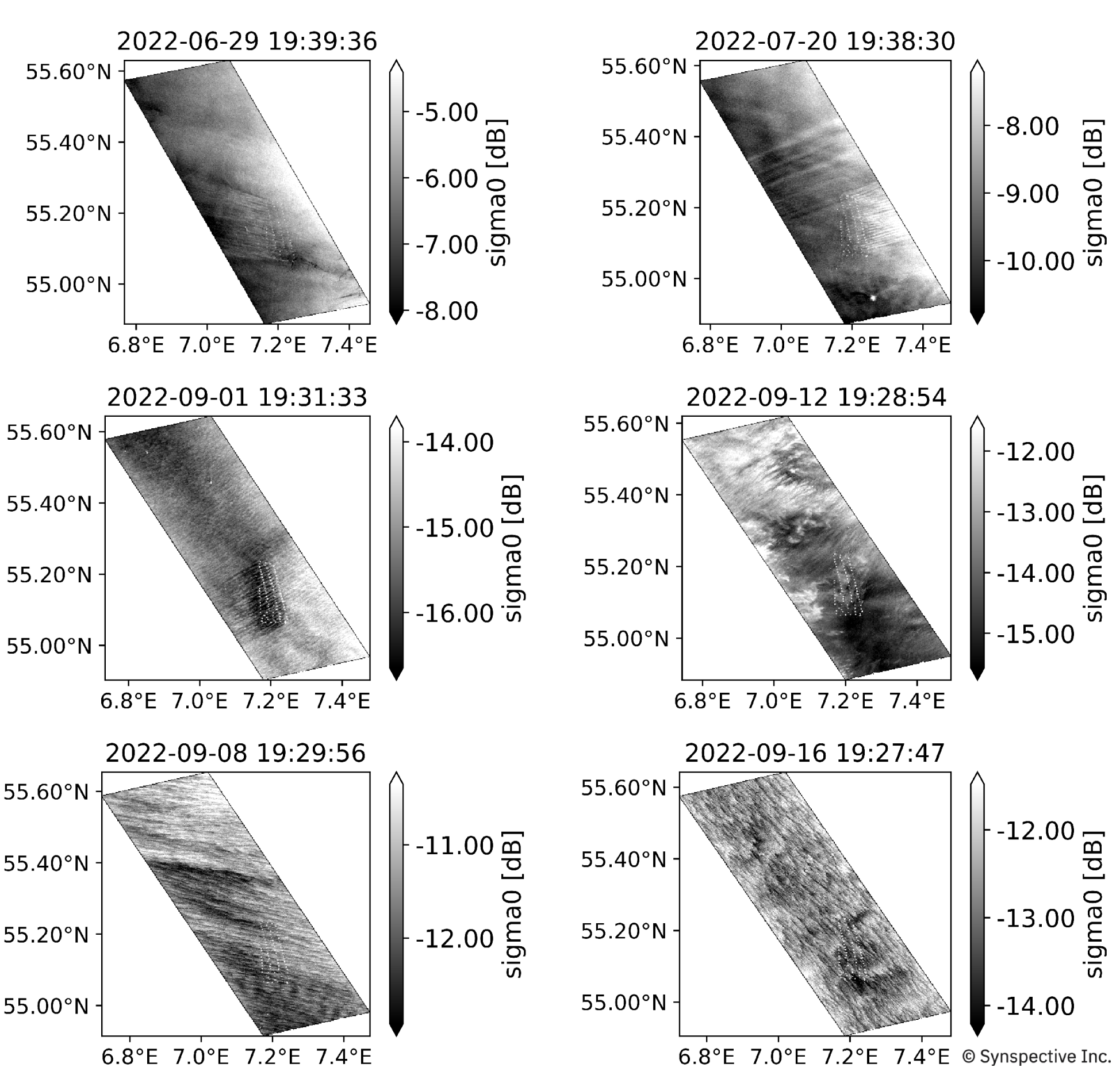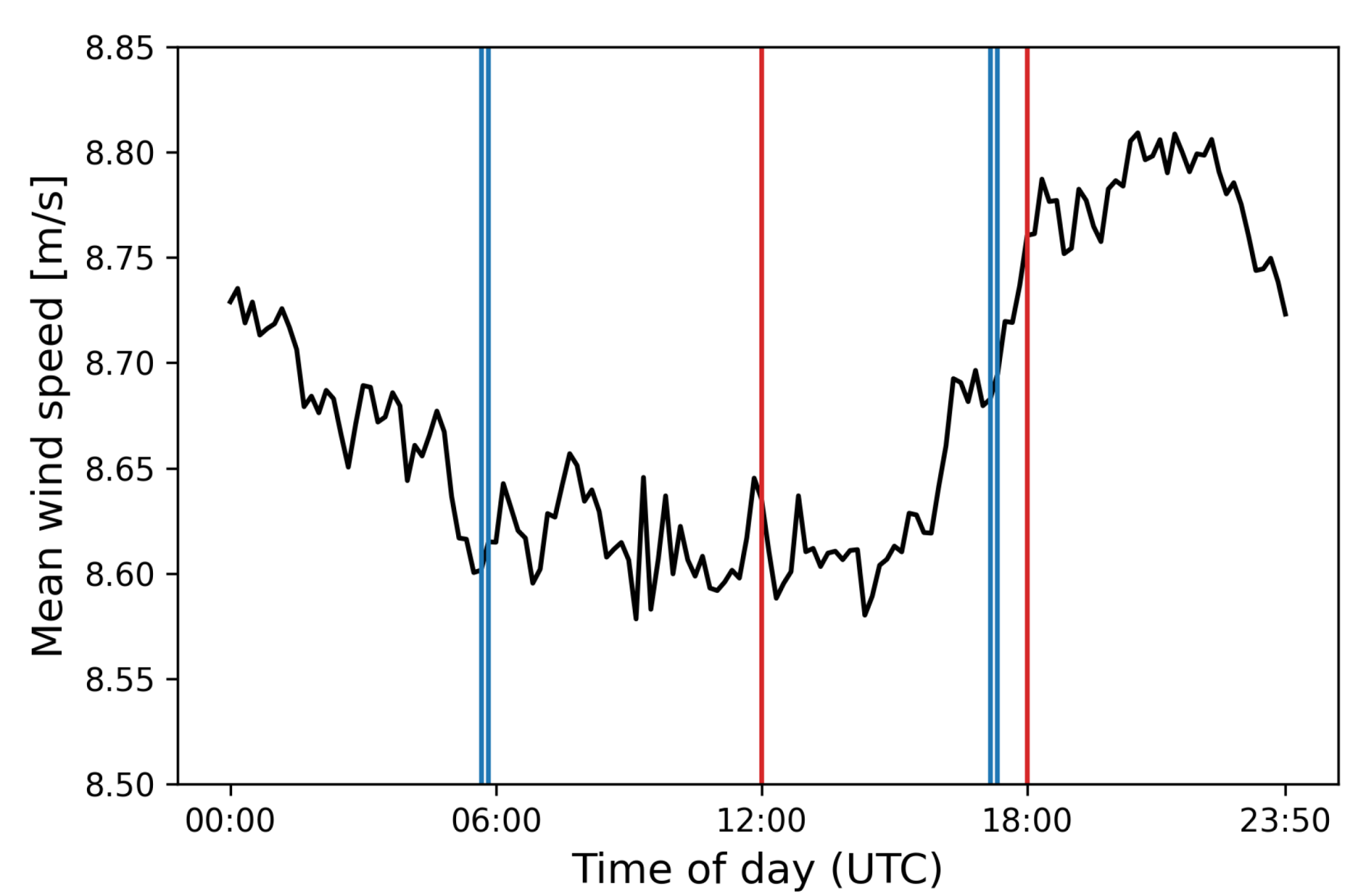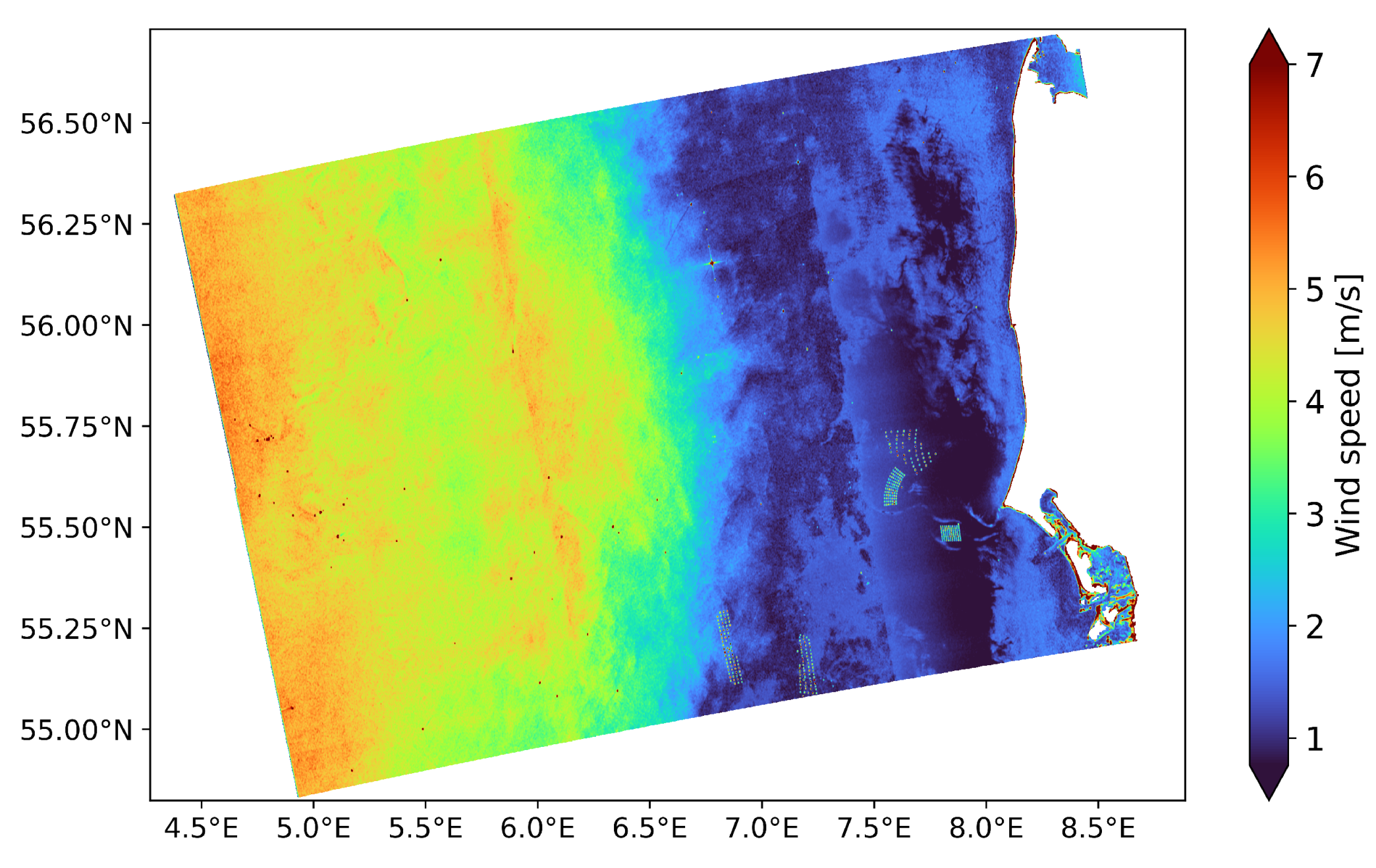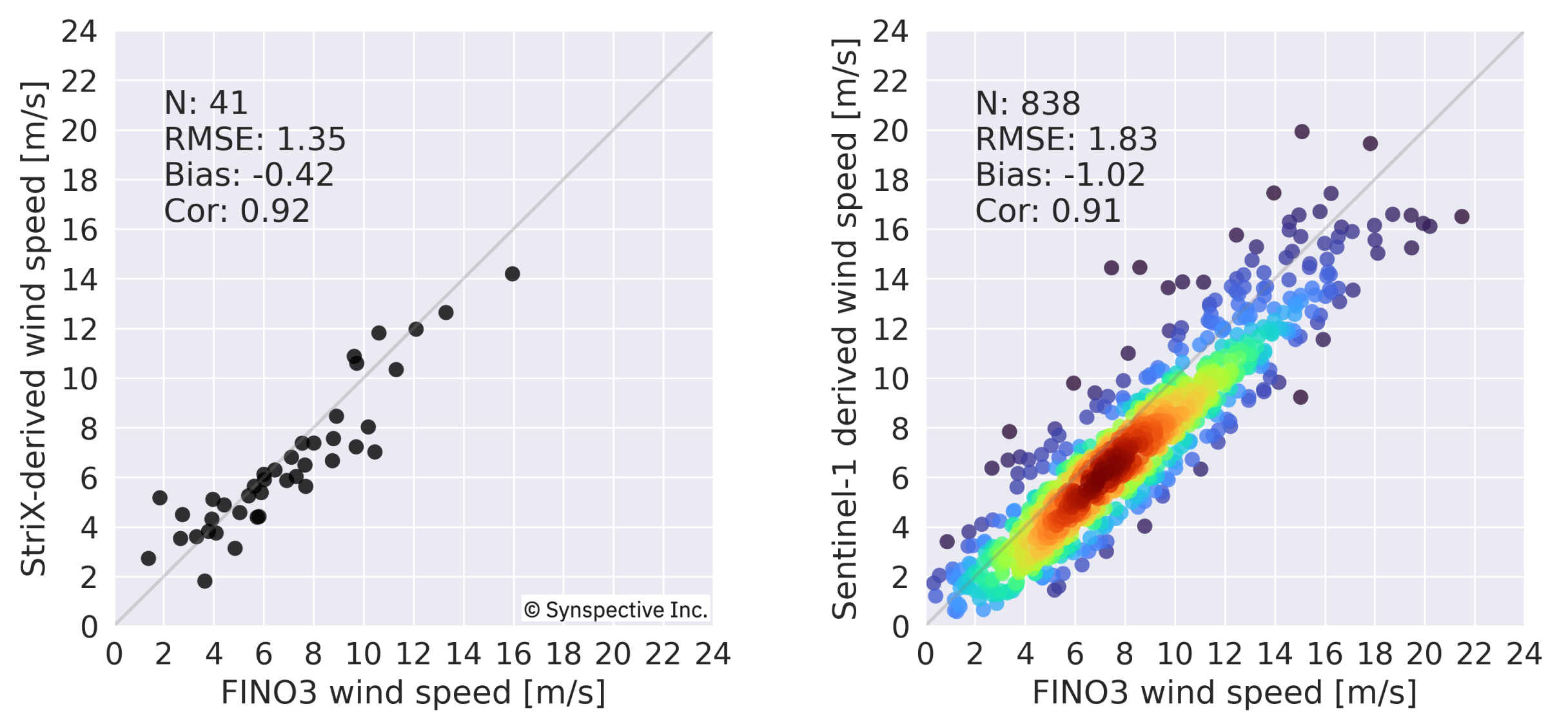Wind Retrieval from Constellations of Small SAR Satellites: Potential for Offshore Wind Resource Assessment
Abstract
1. Introduction
2. Background
3. Data
3.1. Satellite Observations
3.1.1. StriX SAR Scenes
3.1.2. Sentinel-1 SAR Scenes
3.2. Meteorological Mast Observations
4. Methods
4.1. SAR Wind Retrieval
4.2. Comparison with Mast Observations
4.3. Satellite Sampling Analysis
5. Results
5.1. Wind fields from StriX and Sentinel-1
5.2. Wind Speeds from SAR vs. Mast Observations
5.3. Effects of Sampling Scenarios
6. Discussion
7. Conclusions
Author Contributions
Funding
Data Availability Statement
Acknowledgments
Conflicts of Interest
References
- UNFCCC. Paris Agreement; Technical Report; United Nations: Bonn, Germany, 2015. [Google Scholar]
- IRENA. Renewable Power Generation Costs in 2021; Technical Report; International Renewable Energy Agency: Abu Dhabi, United Arab Emirates, 2021. [Google Scholar]
- Wind Europe. Scaling Up Floating Offshore Wind towards Competitiveness; Technical Report; Wind Europe: Brussels, Belgium, 2021. [Google Scholar]
- Ahsbahs, T.; Badger, M.; Karagali, I.; Larsén, X. Validation of Sentinel-1A SAR coastal wind speeds against scanning LiDAR. Remote Sens. 2017, 9, 552. [Google Scholar] [CrossRef]
- Lu, Y.; Zhang, B.; Perrie, W.; Mouche, A.A.; Li, X.; Wang, H. A C-Band geophysical model function for determining coastal wind speed using synthetic aperture radar. IEEE J. Sel. Top. Appl. Earth Obs. Remote Sens. 2018, 11, 2417–2428. [Google Scholar] [CrossRef]
- Takeyama, Y.; Ohsawa, T.; Kozai, K.; Hasager, C.; Badger, M. Comparison of geophysical model functions for SAR wind speed retrieval in japanese coastal waters. Remote Sens. 2013, 5, 1956. [Google Scholar] [CrossRef]
- La, T.V.; Khenchaf, A.; Comblet, F.; Nahum, C. Exploitation of C-Band Sentinel-1 Images for High-Resolution Wind Field Retrieval in Coastal Zones (Iroise Coast, France). IEEE J. Sel. Top. Appl. Earth Obs. Remote Sens. 2017, 10, 5458–5471. [Google Scholar] [CrossRef]
- Wei, S.; Yang, S.; Xu, D. On accuracy of SAR wind speed retrieval in coastal area. Appl. Ocean. Res. 2020, 95, 102012. [Google Scholar] [CrossRef]
- Owda, A.; Badger, M. Wind Speed Variation Mapped Using SAR before and after Commissioning of Offshore Wind Farms. Remote Sens. 2022, 14, 1464. [Google Scholar] [CrossRef]
- Verhoef, A.; Portabella, M.; Stoffelen, A. High-resolution ASCAT scatterometer winds near the coast. IEEE Trans. Geosci. Remote Sens. 2012, 50, 2481–2487. [Google Scholar] [CrossRef]
- Orzel, K.; Fujimaru, S.; Obata, T.; Imaizumi, T.; Arai, M. The on-orbit demonstration of the small SAR satellite. Initial calibration and observations. In Proceedings of the 2022 IEEE Radar Conference (RADARCONF’22), New York, NY, USA, 21–25 March 2022; 2022. [Google Scholar] [CrossRef]
- Stoffelen, A.; Anderson, D.L.T. Scatterometer data interpretation: Estimation and validation of the transfer function CMOD4. J. Geophys. Res. 1997, 102, 5767–5780. [Google Scholar] [CrossRef]
- Quilfen, Y.; Chapron, B.; Elfouhaily, T.; Katsaros, K.; Tournadre, J. Observation of tropical cyclones by high-resolution scatterometry. J. Geophys. Res. 1998, 103, 7767–7786. [Google Scholar] [CrossRef]
- Hersbach, H.; Stoffelen, A.; de Haan, S. An improved C-band scatterometer ocean geophysical model function: CMOD5. J. Geophys. Res. Ocean. 2007, 112, 16. [Google Scholar] [CrossRef]
- Hersbach, H. Comparison of C-Band Scatterometer CMOD5.N Equivalent Neutral Winds with ECMWF. J. Atmos. Ocean. Technol. 2010, 27, 721–736. [Google Scholar] [CrossRef]
- Stoffelen, A.; Verspeek, J.A.; Vogelzang, J.; Verhoef, A. The CMOD7 Geophysical Model Function for ASCAT and ERS Wind Retrievals. IEEE J. Sel. Top. Appl. Earth Obs. Remote Sens. 2017, 10, 2123–2134. [Google Scholar] [CrossRef]
- Dagestad, K.F.; Horstmann, J.; Mouche, A.; Perrie, W.; Shen, H.; Zhang, B.; Li, X.; Monaldo, F.; Pichel, W.; Lehner, S.; et al. Wind retrieval from synthetic aperture radar—An overview. In Proceedings of the SEASAR 2012 Advances in SAR Oceanography, Tromsø, Norway, 18–22 June 2012. [Google Scholar]
- Koch, W. Directional analysis of SAR images aiming at wind direction. IEEE Trans. Geosci. Remote Sens. 2004, 42, 702–710. [Google Scholar] [CrossRef]
- Lehner, S.; Horstmann, J.; Koch, W.; Rosenthal, W. Mesoscale wind measurements using recalibrated ERS SAR images. J. Geophys. Res. Ocean. 1998, 103, 7847–7856. [Google Scholar] [CrossRef]
- Monaldo, F.M.; Beal, R. Wind speed and direction. In Synthetic Aperture Radar Marine User’s Manual; Jackson, C.R., Apel, J.R., Eds.; U.S. Department of Commerce, National Oceanic and Atmospheric Administration: Washingon, DC, USA, 2004; pp. 305–320. [Google Scholar]
- Takeyama, Y.; Ohsawa, T.; Kozai, K.; Hasager, C.B.; Badger, M. Effectiveness of WRF wind direction for retrieving coastal sea surface wind from synthetic aperture radar. Wind Energy 2013, 16, 865–878. [Google Scholar] [CrossRef]
- Li, X.; Lehner, S. Algorithm for sea surface wind retrieval from TerraSAR-X and TanDEM-X data. IEEE Trans. Geosci. Remote Sens. 2014, 52, 2928–2939. [Google Scholar] [CrossRef]
- Li, X.M.; Ren, Y.Z. Mapping of sea surface wind and current fields in the China seas using x-band spaceborne SAR. In Remote Sensing of the Asian Seas; Springer International Publishing: Cham, Switzerland, 2018; pp. 269–284. [Google Scholar] [CrossRef]
- Shao, W.; Li, X.; Yang, X. Retrieval of winds and waves from synthetic aperture radar imagery. In Remote Sensing of the Asian Seas; Springer International Publishing: Cham, Switzerland, 2018; pp. 285–303. [Google Scholar] [CrossRef]
- Ren, Y.; Lehner, S.; Brusch, S.; Li, X.; He, M. An algorithm for the retrieval of sea surface wind fields using X-band TerraSAR-X data. Int. J. Remote Sens. 2012, 33, 7310–7336. [Google Scholar] [CrossRef]
- Nirchio, F.; Venafra, S. XMOD2 - An improved geophysical model function to retrieve sea surface wind fields from Cosmo-SkyMed X-band data. Eur. J. Remote Sens. 2013, 46, 583–595. [Google Scholar] [CrossRef]
- Monaldo, F.; Jackson, C.; Li, X.; Pichel, W.G. Preliminary Evaluation of Sentinel-1A Wind Speed Retrievals. IEEE J. Sel. Top. Appl. Earth Obs. Remote Sens. 2016, 9, 2638–2642. [Google Scholar] [CrossRef]
- Badger, M.; Ahsbahs, T.; Maule, P.; Karagali, I. Inter-calibration of SAR data series for offshore wind resource assessment. Remote Sens. Environ. 2019, 232, 111316. [Google Scholar] [CrossRef]
- Hasager, C.B.; Hahmann, A.N.; Ahsbahs, T.; Karagali, I.; Sile, T.; Badger, M.; Mann, J. Europe’s offshore winds assessed with synthetic aperture radar, ASCAT and WRF. Wind Energy Sci. 2020, 5. [Google Scholar] [CrossRef]
- Takeyama, Y.; Ohsawa, T.; Shimada, S.; Kozai, K.; Kawaguchi, K.; Kogaki, T. Assessment of the offshore wind resource in Japan with the ASCAT microwave scatterometer. Int. J. Remote Sens. 2019, 40, 1200–1216. [Google Scholar] [CrossRef]
- Takeyama, Y.; Ohsawa, T.; Tanemoto, J.; Shimada, S.; Kozai, K.; Kogaki, T. A comparison between Advanced Scatterometer and Weather Research and Forecasting wind speeds for the Japanese offshore wind resource map. Wind Energy 2020, 23, 1596–1609. [Google Scholar] [CrossRef]
- Chang, R.; Zhu, R.; Badger, M.; Hasager, C.; Zhou, R.; Ye, D.; Zhang, X. Applicability of Synthetic Aperture Radar Wind Retrievals on Offshore Wind Resources Assessment in Hangzhou Bay, China. Energies 2014, 7, 3339–3354. [Google Scholar] [CrossRef]
- Chang, R.; Zhu, R.; Badger, M.; Hasager, C.; Xing, X.; Jiang, Y. Offshore Wind Resources Assessment from Multiple Satellite Data and WRF Modeling over South China Sea. Remote Sens. 2015, 7, 467–487. [Google Scholar] [CrossRef]
- Doubrawa, P.; Barthelmie, R.J.; Pryor, S.C.; Hasager, C.B.; Badger, M.; Karagali, I. Satellite winds as a tool for offshore wind resource assessment: The Great Lakes Wind Atlas. Remote Sens. Environ. 2015, 168, 349–359. [Google Scholar] [CrossRef]
- Ahsbahs, T.; MacLaurin, G.; Draxl, C.; Jackson, C.; Monaldo, F.; Badger, M. US East Coast synthetic aperture radar wind atlas for offshore wind energy. Wind Energy Sci. 2020, 5, 1191–1210. [Google Scholar] [CrossRef]
- Troen, I.; Petersen, E.L. European Wind Atlas; Risø National Laboratory: Roskilde, Denmark, 1989; pp. 1–656. [Google Scholar]
- Barthelmie, R.J.; Pryor, S.C. Can satellite sampling of offshore wind speeds realistically represent wind speed distributions. J. Appl. Meteorol. 2003, 42, 83–94. [Google Scholar] [CrossRef]
- Hwang, P.A.; Stoffelen, A.; Van Zadelhoff, G.J.; Perrie, W.; Zhang, B.; Li, H.; Shen, H. Cross-polarization geophysical model function for C-band radar backscattering from the ocean surface and wind speed retrieval. J. Geophys. Res. Ocean. 2015, 120, 893–909. [Google Scholar] [CrossRef]
- Vachon, P.W.; Wolfe, J. C-band cross-polarization wind speed retrieval. IEEE Geosci. Remote Sens. Lett. 2011, 8, 456–459. [Google Scholar] [CrossRef]
- Petersen, E.L.; TROEN, I.; Frandsen, S.; Hedegaard, K. Windatlas for Denmark; Ris¢ National Laboratory: Roskilde, Denmark, 1981; pp. 1–229. [Google Scholar]
- Pyne, B.; Saito, H.; Akbar, P.R.; Hirokawa, J.; Tomura, T.; Tanaka, K. Development and Performance Evaluation of Small SAR System for 100-kg Class Satellite. IEEE J. Sel. Top. Appl. Earth Obs. Remote Sens. 2020, 13, 3879–3891. [Google Scholar] [CrossRef]
- Orzel, K.; Fujimaru, S.; Obata, T.; Imaizumi, T.; Arai, M. StriX-α SAR satellite: Demonstration of observation modes and initial calibration results. Proc. Eur. Conf. Synth. Aperture Radar Eusar 2022, 2022, 165–168. [Google Scholar]
- Shimada, M.; Freeman, A. A technique for measurement of spaceborne SAR antenna patterns using distributed targets. IEEE Trans. Geosci. Remote Sens. 1995, 33, 100–114. [Google Scholar] [CrossRef]
- Leiding, T.; Tinz, B.; Gates, L.; Rosenhagen, G.; Herklotz, K.; Senet, C.; Outzen, O.; Lindenthal, A.; Neumann, T.; Frühmann, R.; et al. Standardisierung und Vergleichende Analyse der Meteorologischen FINO-Messdaten (FINO123); Technical Report; Deutscher Wetterdienst: Offenbach, Germany, 2016. [Google Scholar]
- Portabella, M.; Stoffelen, A. On Scatterometer Ocean Stress. J. Atmos. Ocean. Technol. 2009, 26, 368–382. [Google Scholar] [CrossRef]
- Hasager, C.B.; Dellwik, E.; Nielsen, M.; Furevik, B. Validation of ERS-2 SAR offshore wind-speed maps in the North Sea. Int. J. Remote Sens. 2004, 25, 3817–3841. [Google Scholar] [CrossRef]
- Rannik, U.; Sogachev, A.; Foken, T.; Göckede, M.; Kljun, N.; Leclerc, M.Y.; Vesala, T. Footprint Analysis. In Eddy Covariance; Springer Atmospheric Sciences; Aubinet, M., Vesala, T., Papale, D., Eds.; Springer: Dordrecht, The Netherlands, 2012; pp. 211–261. [Google Scholar] [CrossRef]
- Taylor, G.I. The spectrum of turbulence. Proc. R. Soc. Lond. Ser. Math. Phys. Sci. 1938, 164, 476–490. [Google Scholar] [CrossRef]
- Sikora, T.D.; Thompson, D.R.; Bleidorn, J.C. Testing the diagnosis of marine atmospheric boundary-layer structure from synthetic aperture radar. Johns Hopkins APL Tech. Dig. 2000, 21, 94–99. [Google Scholar]
- El-Darymli, K.; McGuire, P.; Power, D.; Moloney, C. Target detection in synthetic aperture radar imagery: A state-of-the-art survey. J. Appl. Remote Sens. 2013, 7, 12207V. [Google Scholar] [CrossRef]
- de Montera, L.; Remmers, T.; O’Connell, R.; Desmond, C. Validation of Sentinel-1 offshore winds and average wind power estimation around Ireland. Wind Energy Sci. 2020, 5, 1023–1036. [Google Scholar] [CrossRef]
- Hahmann, A.N.; Sīle, T.; Witha, B.; Davis, N.N.; Dörenkämper, M.; Ezber, Y.; García-Bustamante, E.; González-Rouco, J.F.; Navarro, J.; Olsen, B.T.; et al. The making of the New European Wind Atlas – Part 1: Model sensitivity. Geosci. Model Dev. 2020, 13, 5053–5078. [Google Scholar] [CrossRef]
- Sathe, A.; Gryning, S.E.; Pena Diaz, A. Comparison of the atmospheric stability and wind profiles at two wind farm sites over a long marine fetch in the North Sea. Wind Energy 2011, 14, 767–780. [Google Scholar] [CrossRef]
- Coelingh, J.P.; Van Wijk, A.J.M.; Holtslag, A.A.M. Analysis of wind speed observations over the North Sea. J. Wind Eng. Ind. Aerodyn. 1996, 61, 51–69. [Google Scholar] [CrossRef]
- Solyali, D.; Altunç, M.; Tolun, S.; Aslan, Z. Wind resource assessment of Northern Cyprus. Renew. Sustain. Energy Rev. 2016, 55, 180–187. [Google Scholar] [CrossRef]
- Ryu, G.H.; Kim, Y.G.; Kwak, S.J.; Choi, M.S.; Jeong, M.S.; Moon, C.J. Atmospheric Stability Effects on Offshore and Coastal Wind Resource Characteristics in South Korea for Developing Offshore Wind Farms. Energies 2022, 15, 1305. [Google Scholar] [CrossRef]
- Badger, M.; Peña, A.; Hahmann, A.N.; Mouche, A.A.; Hasager, C.B. Extrapolating satellite winds to turbine operating heights. J. Appl. Meteorol. Climatol. 2016, 55, 975–991. [Google Scholar] [CrossRef]
- de Montera, L.; Berger, H.; Husson, R.; Appelghem, P.; Guerlou, L.; Fragoso, M. High-resolution offshore wind resource assessment at turbine hub height with Sentinel-1 synthetic aperture radar(SAR) data and machine learning. Wind Energy Sci. 2022, 7, 1441–1453. [Google Scholar] [CrossRef]
- Optis, M.; Bodini, N.; Debnath, M.; Doubrawa, P. New methods to improve the vertical extrapolation of near-surface offshore wind speeds. Wind Energy Sci. 2021, 6, 935–948. [Google Scholar] [CrossRef]
- Hatfield, D.; Hasager, C.B.; Karagali, I. Vertical extrapolation of ASCAT ocean surface winds using machine learning techniques. Wind Energy Sci. Discuss. 2022, 2022, 1–26. [Google Scholar] [CrossRef]









| StriX- | Sentinel-1 | |
|---|---|---|
| Orbit type | Sun-synchronous | Sun-synchronous |
| Orbit altitude | 560 km | 693 km |
| Orbit inclination | 97.37 | 98.18 |
| Look direction | Left or right | Right |
| Center frequency | 9.65 GHz | 5.405 GHz |
| Chirp bandwidth | 75–300 MHz | 0–100 MHz |
| RF peak power | 1 kW | 4.3 kW |
| Duty cycle | 25% | Max 12% |
| System noise figure | 2.6 dB | 3 dB |
| PRF | 3000–7000 Hz | 1000–3000 Hz |
| Polarization | VV | VV + VH or HH + HV |
| Antenna size | 4.9 × 0.7 m | 12.3 × 0.821 m |
| StriX- | Sentinel-1 | |
|---|---|---|
| Observation mode | Stripmap | Interferometric Wide Swath |
| Off-nadir angle | 19–39 | 26–40 |
| Swath width | 10–30 km (nominal 20 km) | 250 km |
| Azimuth resolution | 2.6 m | 22.5 m |
| Slant range resolution | 1.8 m | Beam-dependent: 2.7–3.5 m |
| Lat° | Lon° | Wind Speed [m] | Wind Direction [m] |
|---|---|---|---|
| 55.20 | 07.16 | 31, 41, 51, 61, 71, 81, 91, 101, 107 | 29, 101 |
| Moments | Weibull Params | ||||||||
|---|---|---|---|---|---|---|---|---|---|
| Height | Mean | Std Dev | Shape | Scale | E | ||||
| Observation Scenario | [m] | [m s] | [m s] | Skewness | Kurtosis | (k) | (c) | [W m] | N |
| (1) Entire dataset (no condition) | 31 | 8.68 | 4.18 | 0.51 | 0.05 | 2.19 | 9.80 | 702 | 352,112 |
| (2) Fixed times = [5:40, 5:50, 17:10, 17:20] | 31 | 8.65 | 4.19 | 0.52 | 0.06 | 2.18 | 9.77 | 700 | 9788 |
| (3) 2 m s | 31 | 8.91 | 4.03 | 0.43 | −0.07 | 2.35 | 10.06 | 718 | 341,938 |
| (4) Cumulative criteria of (2) and (3) | 31 | 8.89 | 4.05 | 0.44 | −0.05 | 2.33 | 10.03 | 715 | 9504 |
| (5) Sentinel-1 acquisition times | 31 | 8.60 | 4.09 | 0.49 | 0.02 | 2.23 | 9.71 | 674 | 1329 |
| (6) Daily (every noon) | 31 | 8.64 | 4.18 | 0.52 | 0.06 | 2.18 | 9.76 | 696 | 2430 |
| (7) Daily (every evening) | 31 | 8.76 | 4.25 | 0.52 | 0.06 | 2.17 | 9.89 | 728 | 2455 |
| (8) Hourly | 31 | 8.68 | 4.18 | 0.51 | 0.05 | 2.19 | 9.80 | 701 | 58,697 |
| Moments | Weibull Params | |||||||
|---|---|---|---|---|---|---|---|---|
| Height | Mean | Std Dev | Shape | Scale | E | |||
| [m] | [m s] | [m s] | Skewness | Kurtosis | (k) | (c) | [W m] | N |
| 107 | 9.67 | 4.77 | 0.55 | 0.10 | 2.13 | 10.91 | 995 | 364,619 |
| 101 | 9.55 | 4.68 | 0.54 | 0.09 | 2.15 | 10.78 | 952 | 349,642 |
| 91 | 9.48 | 4.65 | 0.54 | 0.09 | 2.14 | 10.70 | 932 | 352,120 |
| 81 | 9.35 | 4.60 | 0.54 | 0.09 | 2.14 | 10.56 | 897 | 338,033 |
| 71 | 9.30 | 4.53 | 0.53 | 0.07 | 2.16 | 10.50 | 873 | 351,859 |
| 61 | 9.11 | 4.44 | 0.53 | 0.07 | 2.16 | 10.29 | 821 | 352,170 |
| 51 | 8.99 | 4.35 | 0.52 | 0.06 | 2.18 | 10.16 | 785 | 351,375 |
| 41 | 8.85 | 4.26 | 0.51 | 0.05 | 2.19 | 10.00 | 745 | 352,461 |
| 31 | 8.68 | 4.18 | 0.51 | 0.05 | 2.19 | 9.80 | 702 | 352,112 |
Disclaimer/Publisher’s Note: The statements, opinions and data contained in all publications are solely those of the individual author(s) and contributor(s) and not of MDPI and/or the editor(s). MDPI and/or the editor(s) disclaim responsibility for any injury to people or property resulting from any ideas, methods, instructions or products referred to in the content. |
© 2023 by the authors. Licensee MDPI, Basel, Switzerland. This article is an open access article distributed under the terms and conditions of the Creative Commons Attribution (CC BY) license (https://creativecommons.org/licenses/by/4.0/).
Share and Cite
Badger, M.; Fujita, A.; Orzel, K.; Hatfield, D.; Kelly, M. Wind Retrieval from Constellations of Small SAR Satellites: Potential for Offshore Wind Resource Assessment. Energies 2023, 16, 3819. https://doi.org/10.3390/en16093819
Badger M, Fujita A, Orzel K, Hatfield D, Kelly M. Wind Retrieval from Constellations of Small SAR Satellites: Potential for Offshore Wind Resource Assessment. Energies. 2023; 16(9):3819. https://doi.org/10.3390/en16093819
Chicago/Turabian StyleBadger, Merete, Aito Fujita, Krzysztof Orzel, Daniel Hatfield, and Mark Kelly. 2023. "Wind Retrieval from Constellations of Small SAR Satellites: Potential for Offshore Wind Resource Assessment" Energies 16, no. 9: 3819. https://doi.org/10.3390/en16093819
APA StyleBadger, M., Fujita, A., Orzel, K., Hatfield, D., & Kelly, M. (2023). Wind Retrieval from Constellations of Small SAR Satellites: Potential for Offshore Wind Resource Assessment. Energies, 16(9), 3819. https://doi.org/10.3390/en16093819






